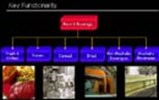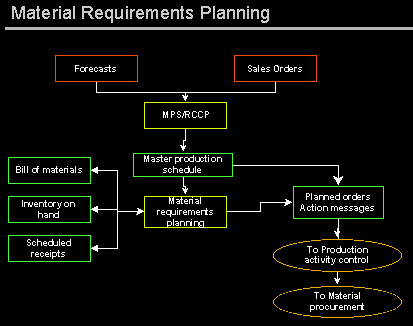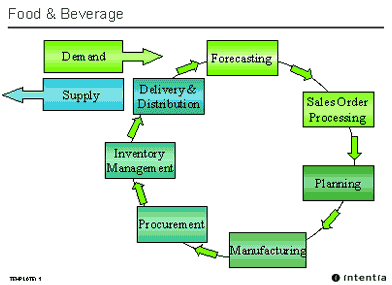Food & Beverage Companies Need to Integrate Information Enterprise-Wide
 Challenged by market demand for greater variety and rapid product development, combined with retailer demand for efficient replenishment and timely distribution, food and beverage manufacturers and distributors are increasingly turning to enterprise management technology solutions.
Challenged by market demand for greater variety and rapid product development, combined with retailer demand for efficient replenishment and timely distribution, food and beverage manufacturers and distributors are increasingly turning to enterprise management technology solutions.
Table of Contents
The Role of Technology - Up to Now
What's Needed to Improve Bottom Line Performance?
Brand Management/Delivery is a Key to Success
How Enterprise Resource Planning Can Help
Implementing ERP: Look Before You Leap
Industry-Specific Functionality: The Key to Success
The Result? Increased Productivity, High Customer Satisfaction, Sustainable Growth
Companies in the food and beverage industries have many commonalities and a few differences. However, whether they are producers or distributors of canned goods, fresh or frozen products, beverages or long shelf-life products, all are experiencing rapid changes in the way they have to do business. For one thing, increased commoditization and diversification of food and beverage products has made it more difficult than ever for food and beverage manufacturers to differentiate themselves, their products and their brands.
In addition, more informed consumers are demanding greater product variety, higher levels of service and more value for their money. Increased global competition and escalating retailer demands – to say nothing of increasingly stringent government regulations – have added to the pressure, making it harder for small to midsize companies to compete with global industry giants. And with customers, consumers and the media growing more concerned with food safety issues, these companies are also finding it necessary to monitor and track every phase of operation – from raw ingredients through finished product, to packaging, storage and distribution – to ensure compliance with the latest safety standards.
Driven by these challenges, companies are looking more and more to their manufacturing processes and supply chain in an effort to increase production efficiency, reduce operational costs and effect better overall management of the enterprise and its assets to sustain desired levels of profitability and growth.
The Role of Technology – Up to Now
Historically, in the food and beverage industry, there has been a lot of resistance to technology, except perhaps to automate certain production processes (e.g. mixing, canning, bottling and packaging). In many midsize and larger companies, the use of information technology (IT) has been limited to off-the-shelf or custom-tailored systems implemented to assist employees with such discrete business processes as accounting, corporate finance, HR and purchasing. In the past decade or so, many firms have implemented Electronic Data Interchange (EDI) systems, often as a response to customer demand. Yet, despite all of the information flowing through these disparate systems, integration of the information across the enterprise in food and beverage companies is rare.
As a result, organizations lack the timely financial information integrated with order and production flow that would enable them to know where they stand from day to day, both from a financial and operations point of view. Currently, in most companies, by the time financial information becomes available in a report, it's historical -- and too late to change course to correct problems. In today's fast-paced global economy and this rapidly changing marketplace, the lack of integrated, real-time information to provide business analysis, business intelligence and decision support is negatively impacting on profitability and hampering growth.
What's Needed To Improve Bottom Line Performance?
Priorities as well as challenges may differ depending on a company's core product offerings and the markets they serve. For example, companies producing perishable or shelf-dated food products may take an order, process and ship it, all in the course of a single shift or working day. For them, efficient order entry, materials and inventory control and fast turnover are paramount to minimizing costly waste and delivering efficient customer service. On the other hand, if a company's business is frozen foods, once the product is made and frozen, time is not nearly so critical – but storage, transportation and distribution are.
On the beverage side, we see an astonishing level of diversification fragmenting this industry. Where once there was a finite number of carbonated and non-carbonated soft drinks occupying the competitive landscape, today there is an almost infinite explosion of choices – from pure juice and juice blends, to sodas of every kind, "designer" beers, flavored waters, energy-producing drinks, and a host of "neutraceutical" beverages incorporating various health remedies. Sales in this arena are market-driven, so producers tend to rely on special packaging, pricing, event-driven promotions and other attention-getting techniques to differentiate themselves. For them, forecasting and timing of product-to-market are crucial. Market-driven companies need to be able to put a product out on the shelves, see how it sells, then turn on a dime to adjust production to match demand. This is not an easy task.
Brand Management/Delivery is a Key to Success
These examples illustrate that each segment of the food and beverage industry has its own challenges to overcome whether it competes in local, regional, national or global markets. However, if they want to retain customers and grow market share, all food and drink manufacturers and distributors need greater flexibility and agility to respond quickly – whether to changing customer expectations, government regulations, or fluctuations in the marketplace resulting from seasonal changes in eating and drinking patterns. In short, companies are finding they have to increase the speed or decrease the lag time between when their products are made and when they are sold.
To coordinate their production capabilities, manufacturers need to increase their ability to handle different materials and product lines simultaneously. If they are to improve procurement and inventory control, they must find a way to accurately track both raw materials and finished goods. And, to build their company and product brands among customers and consumers, they must be able to ensure consistency of quality across product lines.

On the business end, optimizing plant operations can be a tremendous source of savings. Companies attaining high visibility and close control of key production elements – equipment, materials and labor – can simplify complexity and better manage cash flows. They can forecast more closely to customer demand – avoiding either overextending or underproducing – to improve their return on corporate assets.
How Enterprise Resource Planning Can Help
Many people tend to think Enterprise Resource Planning (ERP) systems are solely for discrete rather than process manufacturers. While this may once have been the case, it is true no longer. In today's marketplace, there are systems having both discrete and process capabilities. As a result, manufacturers of both types can implement enterprise-wide information technology systems to better control internal operations and manage their supply chain, from material suppliers at one end to distributors, retailers and consumers at the other. In addition, a well-managed ERP system can make it much easier to monitor key Good Manufacturing Practices (GMP) and HACCP (Hazard Analysis Critical Control Points) actions and assure documented compliance.
Specifically, an ERP system will provide integrated flow of information to link the financial/accounting and executive performance functions to the order entry, manufacturing and distribution sides of the business.

If the system is well matched to the business and well implemented, the result of this integration is:
- Decreased reaction times, resulting in reduced lead times, better logistics flow, and increased responsiveness to market and customer changes.
- Smaller inventories due to more accurate forecasting, more efficient procurement and distribution.
- Improved order management and fulfillment for higher customer satisfaction.
- Improved supply chain management and coordination to better align production with demand.
- Optimized product quality and production scheduling, leading to better cash flow and management, increased return on capital equipment.
- Improved utilization of capital equipment and labor resources.
- More and better real-time business intelligence to support strategic decisions and plans for growth.
Implementing ERP: Look Before You Leap
As a company begins to evaluate the ERP marketplace, corporate management and the information technology staff (or the technology partner) should formulate a comprehensive list of selection criteria that meet their most pressing business requirements. This exercise will give them a baseline or decision matrix against which to measure the offerings of various ERP vendors. For midrange companies particularly, ease of implementation and ease of use are among the key factors to look for. Additional decision factors include:
- Core functionality of the system. Look for a proven technology platform and strong financial applications, as well as procurement, order entry and fulfillment, planning and scheduling, inventory management and optimization, product configuration, flexible product costing, manufacturing, EDI capabilities, and support of multiple plants and/or warehouses and complex distribution system.
- Customer information capture and business chain management to provide business intelligence and decision support to the marketing and sales organization and corporate management.
- Interface capabilities with existing data capture, MES, and warehouse management systems.
- A proven implementation methodology and rapid implementation tools focused on fast implementation and deliverables, key business benefits and rapid ROI will help to achieve successful implementation in the shortest possible time and with the least disruption.
- Industry-specific features and functions. Some ERP systems are designed more for discrete manufacturing operations than processing and do not operate at the plant level. For food and drink manufacturers, where throughput time can be measured in hours or days rather than weeks or months, implementing an ERP system with functions designed to fit their business processes will hasten implementation and return on investment.
Industry-Specific Functionality: The Key to Success
When an ERP implementation fails, generally the buyer blames the system's complexity and poor functionality. While this is sometimes true, more often the failure results from the buyer not being fully prepared for the scope of changes required, or from incompatibility between the system's processes and the way the company actually does business. Problems of this kind can be avoided by selecting a system designed specifically for a particular business or industry. Food and beverage manufacturers should consider such industry-specific functions as:
- Support of both batch and continuous process operations.
- Support of make-to-stock or make-to-order environments.
- Flexible recipe/formula management allowing recipe variations to meet seasonal ingredient availability, nutritional standards, or quality adjustments for taste and texture.
- Flexible forecasting and optimized raw materials procurement and utilization.
- Perishable goods handling to include servicing and replenishing customers according to acceptable sell by/expiration dates.
- Reverse Bill of Material support for manufacturing requiring disassembly of incoming materials before production can take place (e.g. poultry and meat processing).
- Production rate planning to optimize synchronization between production and demand.
- Transportation and distribution planning and logistics optimization.
- Comprehensive support of compliance with USDA and FDA regulations – e.g. complete traceability from raw materials to finished product, automatic lot inspection, HACCP, etc.
- Promotion management to enable developing of a marketing plan and monitoring the market and performance regularly.
The Result? Increased Productivity, High Customer Satisfaction, Sustainable Growth
Enterprise Resource Planning and supply chain optimization represent the wave of the future because of their anticipated long-term benefits to the organization. Some of the largest players in the food and beverage industries have already adopted ERP to run their companies more efficiently. Growth-oriented small to midsize companies would do well to tap into the power of this technology too. It can help level the playing field between them and larger competitors – and a whole lot more.
With integrated information across the enterprise integrating manufacturing, distribution, financial and executive performance management, a company can become more customer-focused. People can easily access the data to provide fast responses to customer inquiries and demands, which inevitably leads to higher customer satisfaction and increased retention. The capture and analysis of customer information from transactional processes provides sales, marketing and corporate management with valuable business intelligence upon which to base future decisions and market and promote new and mature product lines. And, with an ERP system providing a global view of the business from order entry to distribution, the company gains enhanced visibility and agility, enabling it to ramp up production and optimize logistics to meet market demand.
ROI has been both swift and substantial – usually within a year of implementation – for companies investing in an integrated, industry-specific ERP solution. Savings generated by increased operational efficiencies and production throughput can be invested back into the business – for example, purchasing new equipment, expanding product research and development, and opening new marketing and distribution channels. As manufacturers in other industries have already shown, over the long haul a strategic ERP investment can be a direct path to market leadership and long-term sustainable growth. The time is right for food and beverage manufacturers to get on board.
Dennis Bingham is Food & Beverage Industry Applications Manager for Intentia International Americas Group. With more than 25 years of industry experience, Bingham was previously director of manufacturing for Tyson Foods' Culinary Foods Division and has held positions with Ralston Purina and ConAgra.
